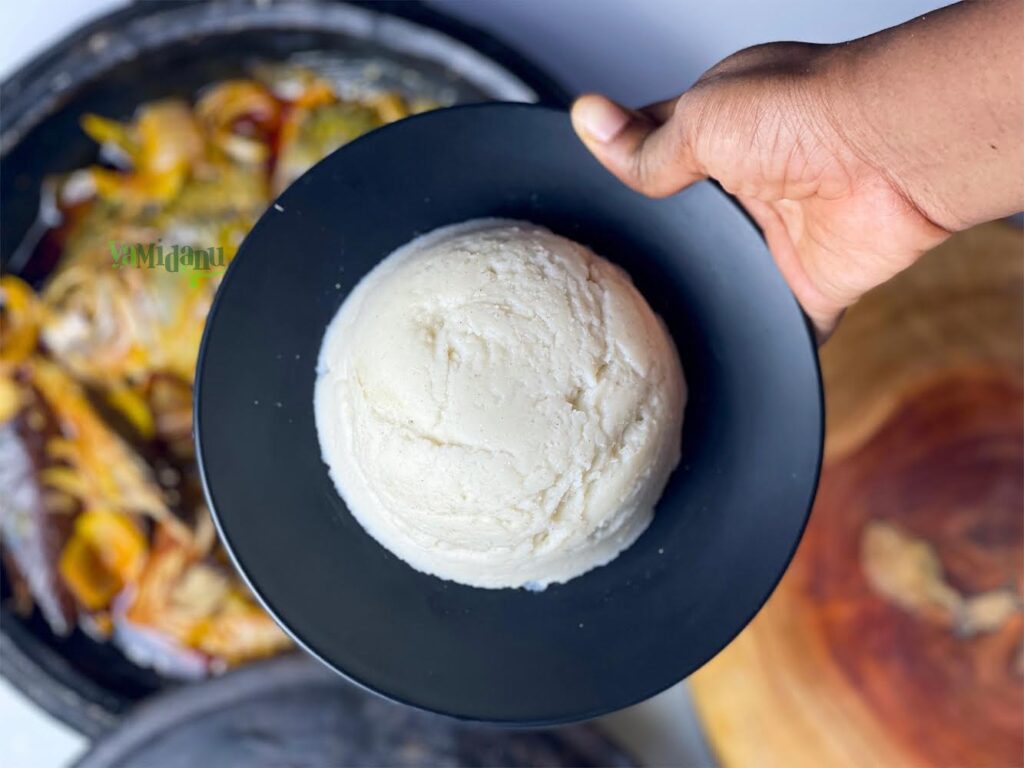Akple is a popular dish in Ghana. However, there are some misconceptions surrounding the term “Akple” as a result of cultural diversity and cultural assimilation. A common misconception is the fact that most Ghanaians, especially the non-speaking ewe tribes in Ghana, believe that Akple is an actual dish on its own. However, this notion is far from true.
In this article, you get to learn:
- What Akple is
- Types of Akple
- Amorkple and how it is prepared
- Eworkple and how it is prepared
- Dzenkple and how it is prepared
- Molukple and how it is prepared
WHAT IS AKPLE?

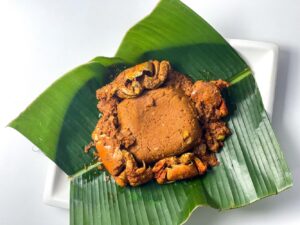
If you hail from or ever lived in any of the English-speaking countries in Africa like Ghana, Togo, Benin, and the Southern part of Nigeria, then the term “Akple” is certainly not new to you. Akple is a staple food of the Ewe’s in Ghana, Togo, and some other African countries but enjoyed by many. Akple is a general name given to a variety of food prepared or cooked by way of mashing food substance with the help of a wooden ladle, “Akpledatsi” which translates to “Akple cooking stick.”
TYPES OF AKPLE
Akple comes in various forms. We have;
- Amorkple made with a mixture of corn and cassava dough
- Eworkple made with milled corn or corn powder
- Dzenkple which is basically stewed roasted corn flour
- Ayikple with its main ingredient being beans
- Molukple prepared with rice,
- Fokple made from millet
- Likple made from sorghum and many others.
AMORKPLE AND HOW IT IS PREPARED
AMORKPLE

It is the Lord and Saviour of all Akples. It is prepared with fermented cassava dough and milled corn and is similar to Banku a dish from the Ga Adangme people along the southeastern Coast of Ghana and Etew of the fantes in Ghana. It is convenient and enjoyed by the majority of Ghanaians. It has a sour taste due to the fermentation process it
undergoes and can be eaten with a wide variety of soups (“Detsi”) or sauce (“Ataadi”). Amorkple is known to have a long shelf life and can be stored in the fridge or freezer for weeks without going bad.
INGREDIENTS
- Cassava Dough
- Milled corn
- Salt
- Water
PREPARATION
- In a cooking pot, mix equal portions of cassava dough and milled corn in a of ratio 1:1 or more cassava than corn in the ratio 1 ½ : 1, if you want a softer and lighter outcome.
- Add water and mix till smooth.
- Mix till a semi-thick and uniform consistency is achieved
- Add a little salt to taste and cook on medium heat.
- With the help of the akpledatsi, stir or paddle mixture gradually applying pressure to smoothen lumps. Do
this till mixture completely thickens.
- Once too thick to handle add a little water and continue paddling till desired consistency is achieved.
- Reduce heat and cover to allow steam cook akple thoroughly.
- Scoop with a wet ladle or bowl and wrap in leaves or rubber.
- Pair with any soup or stew of choice. The options are limitless.
Enjoy!
EWORKPLE AND HOW IT IS PREPARED
EWORKPLE


The Holy Grail of Akples! Interestingly, this is what the other ethnic tribes in Ghana refer to as Akple. It is originally prepared with milled corn or corn powder (corn meal) but in recent times there has been a new development of adding some amount of rice to the maize or corn before milling or grinding into powder form. Others also incorporate a small amount of dried cassava granules “Gari” during the cooking process. This new addition serves as a binding agent that introduces an element of starch into the Eworkple and prevents it from scattering when eating.
Eworkple is a very nutritious dish and is considered a healthy alternative to Amorkple because of the high amount of fibre present in corn and the absence of any fermentation process. Unlike Amorkple, Eworkple has a short shelf life and must be eaten on the same day it is prepared.
INGREDIENTS
- Milled corn or Corn Powder (corn meal)
- Salt
- Water
PREPARATION
- Mix corn meal with water to make a corn meal solution.
- Fill a cooking pot with a substantial amount of water with little to no salt and bring water to a boil.
- Add corn meal solution to boiling water to make corn meal porridge.
- Fetch some of that cornmeal porridge and set aside for later.
- Next, gradually add some corn meal or corn powder to cornmeal porridge on fire while stirring concurrently with your akpledatsi till everything comes together.
- If the mixture becomes too hard and unable to handle, occasionally add the set-aside corn meal porridge to the mixture and paddle till desired consistency is achieved
- Cover to allow steam to cook akple thoroughly.
- Serve right out of the pot, piping hot, or mold into the desired shape of choice for a more aesthetically pleasing look.
- Serve with any soup or stew of choice, however, Eworkple is best served with “Abobi taadi” Anchovies Stew, Pounded Okra Sauce “Fetri Toto” or Okra Soup “Fetri Detsi”
Enjoy!
DZENKPLE AND HOW IT IS PREPARED
DZENKPLE

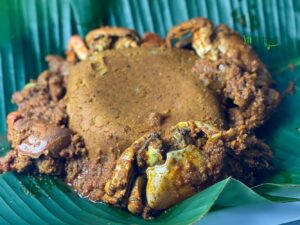
Dzenkple or as I like to call it, “The Jollof of all Akples,” is one of the dishes held in high esteem by the ewe tribe of Ghana. It is often served and eaten on special occasions. Dzenkple is prepared by dry pan-roasting maize or corn. Roasted maize is then milled into powder form and cooked in a rich delicious tomato stew base. There are
different kinds of dzenkple depending on the star protein used. We have; Chicken Dzenkple “Koklo Dzenklpe”, Anchovies Dzenkple “Aborbi Dzenkple”, Crab Dzenkple “Galaan Dzenkple” and many more. Dzenkple is often confused with the Akan traditional meal Aprapransa and Akplijii, a traditional Ga Adangbe dish which is prepared
by combining roasted corn flour with palm-nut soup. If you ever find yourself at any traditional ewe event, dzenkple is one dish to look out for. A taste would have you asking for more.
INGREDIENTS
- Roasted corn flour – ewor t)toe
- Palm oil (dzomi)
- Crabs- Galaan
- Smoked Dried Shrimps- borlu
- Smoked Dried herrings (dzador)
- Tomatoes/ Pepper
- Tomato paste
- Pepper/ Onion
- Ginger / Garlic
- Aniseed/ Calabash nutmeg
- Salt / Seasoning cube (optional)
PREPARATION
- Prepare your ingredients; clean crabs, make ginger marinade for crab by blending together onion, ginger, garlic and aniseed.
- To make pepper mix, blend together onion, tomatoes, pepper, ginger, garlic, bay leaf, aniseed and calabash nutmeg
- Season and steam crabs with ginger marinade and a pinch of salt to taste
- In your cooking pot, pour in some palm oil, add some sliced onion to sizzling oil
- Add tomato paste (cook for 3 minutes), add blended pepper mix, and add salt and seasoning of choice
- Now to the fun part: add powdered herrings and shrimp powder. This is one step you must not skip. It is the key to achieving a flavor-bursting dzenkple. Cook for 15 minutes.
- Once the palm oil stew base is cooked, add steamed crabs to the stew to absorb its rich, delicious flavour.
Take out crabs after 5 minutes.
- Add some water to stew base and bring to a boil. fetch some of that sauce into a bowl and set aside.
- Gradually add roasted corn flour to stew base
- Next, bring out the secret weapon; using the akpledatsi, stir and paddle till everything is well combined and uniform whilst gradually adding sauce that was set aside.
- Cover and reduce heat to allow steam cook akple thoroughly.
- Mold into desired shape and beautifully garnish with stewed crabs.
Enjoy!
MOLUKPLE AND HOW IT IS PREPARED
MOLUKPLE
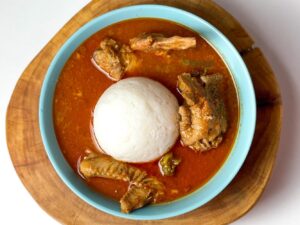
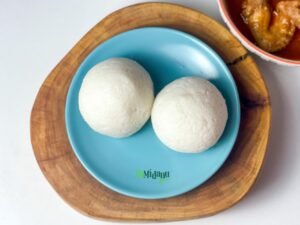
Molukple is a popular rice dish enjoyed and adopted by the various ethnic groups in Ghana, Ewes included. It is the same as Omu Tuo, which originates from the Hausa people of Ghana. it is prepared by cooking very soft sticky rice
which is later mashed and molded into balls. Molukple is best served with Peanut soup, “Adzi detsi,” or Palmnut
soup “Dedetsi”.
INGREDIENTS
- 2 cups of Rice
- 4 cups of Water
- A pinch of Salt
PREPARATION
- Bring water and a pinch of salt to a boil.
- Add washed rice cover and leave to cook on low heat to prevent rice from burning or “kanzo” from forming; the goal is to achieve a mushy, textured rice.
- Once rice is thoroughly cooked and mushy, grab your akpledatsi and mash and knead the rice against the side of your cooking pot.
- Scoop mashed rice with a wet spoon or bowl and mold into sizeable round balls.
- Serve with any soup of choice
Enjoy!
Written by Vamidanu
Social media handles
Instagram | YouTube | Facebook| Tiktok @vamidanu
Gmail Vamidanu@gmail.com
